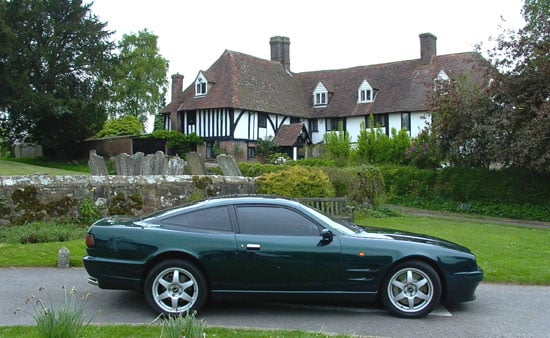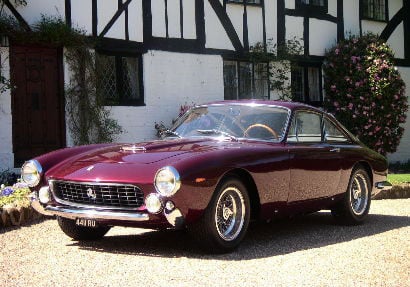Most people will be familiar now with the work of Lynx, based at St Leonards, near Hastings, on the South Coast of England. Their reputation as the world’s foremost restorers of Jaguar’s C, D and lightweight E racing cars goes before them and many will have read articles on the yellow ex-Yamaha Ford GT40 and the awesome 725bhp Virage Turbo. But a day spent with managing director John Mayston-Taylor, and a trip in the Virage, reveals there is more to the company than pure engineering excellence.

Coming from a family background of Jaguar ownership and as a Jaguar enthusiast and experienced racer, Mayston-Taylor’s involvement with Lynx dates back to 1990 when his family were clients of Lynx. He then bought it as a business venture and set about applying his meticulous standards of presentation and professionalism to a company that already had a world wide reputation for both its restoration business and the production of ‘Lynx D-types’ and the ‘Lynx Eventer’. The principal was simple, John, as a former client, knew exactly what was required in order to keep the most fastidious customer happy; and he also knew what upset them most. So he introduced a highly developed system of project management which ensured throughout the life of either a restoration or a new-car build the parts are ordered on time, third party suppliers (Lynx will outsource engineering work to experts in fields outside its own sphere of working) deliver promptly and to specification, and the customer is kept fully informed via digital photos of the progress of his project. As Mayston-Taylor says “It’s simple business principles which a lot of people neglect. To a very busy, successful person these cars are their relaxation, their hobby, and a way of being in total charge of an interest outside work. We want to make the whole process as enjoyable as possible, right from the point of commissioning to the eventual handover.”
 Walking round the workshops reveal the strong Jaguar connection as well as an Aston Martin DB2 in for a service, a Ferrari 250GT Lusso receiving its final preparation prior to that weekend’s AMOC Concours (it won the ‘Associate Class’), a twin-turbo Ferrari F50 and the Virage Turbo. The latter two both customer cars in the long-term care of Lynx. Having had most of the original lightweight E-types in his hands over the years it’s not surprising a large part of Mayston-Taylor’s business is either improving road cars or preparing racers for the big events like Goodwood and Monterey. I suppose the last big un-restored lightweight ‘E’ was the Kjell Qvale US car which Lynx restored from ‘barn-find’ to ‘race-prepared’ in 1999, interestingly John has a large scale model of this particular car in his reception “We presented the owner with one when the car was completed, and had another done for ourselves to remind us of a very exciting project”. The modern E-type owner can choose from a menu of performance improvements, ranging from braking and suspension modifications to engine enhancement and full chassis restoration (“We automatically replace the front chassis frames with new, uprated Reynolds tubing. All the originals are now past their ‘life’. It’s a safety issue”).
Walking round the workshops reveal the strong Jaguar connection as well as an Aston Martin DB2 in for a service, a Ferrari 250GT Lusso receiving its final preparation prior to that weekend’s AMOC Concours (it won the ‘Associate Class’), a twin-turbo Ferrari F50 and the Virage Turbo. The latter two both customer cars in the long-term care of Lynx. Having had most of the original lightweight E-types in his hands over the years it’s not surprising a large part of Mayston-Taylor’s business is either improving road cars or preparing racers for the big events like Goodwood and Monterey. I suppose the last big un-restored lightweight ‘E’ was the Kjell Qvale US car which Lynx restored from ‘barn-find’ to ‘race-prepared’ in 1999, interestingly John has a large scale model of this particular car in his reception “We presented the owner with one when the car was completed, and had another done for ourselves to remind us of a very exciting project”. The modern E-type owner can choose from a menu of performance improvements, ranging from braking and suspension modifications to engine enhancement and full chassis restoration (“We automatically replace the front chassis frames with new, uprated Reynolds tubing. All the originals are now past their ‘life’. It’s a safety issue”).
A lightweight Lynx ‘Low Drag’ E-type holds centre stage in the factory floor. A manufacturer in their own right, Lynx cannot really call these, or the Ds, Cs and XKSSs they also make, ‘replicas’. A faithful reproduction of the Malcolm Sayer designed all-silver Peter Lindner car, (the original of course restored by the company in the ‘80s), the car is nearing completion and will make a wonderful vehicle for doing the Ecurie Ecosse Tour, some track-day work, and generally just making life easier after a long day in the office. Typical of Mayston-Taylor’s attention to detail is the blue ‘Le Mans’ identification light on the roof, sourced from an obsolete Renault saloon of the day and the wonderful aircraft-riveted tail – down to exactly the right number of dome headed fasteners. The engine can be built to any specification but at present does not have fuel injection “For ultimate power on the track yes, but for everyday use three Webers are more than adequate, and for road cars the SU set-up more refined still.”
 |
 |
 |
Having driven down to the South Coast the original intention was to test the Lynx XKSS – which had been sold the week before. So, never one to turn down a spin in a 700+bhp car, I accepted an offer from Andrew Parkinson, the car’s engineering ‘architect’, for a run out in the Kent countryside in the Virage Turbo. Much been has written about the car, how its owner wanted to retain the classic British marque’s anonymity, and that no bodywork changes or vents and scoops should give away its intentions. The whole car must have represented one of the all-time engineering challenges and is testament to the skill of the St Leonards team. The full facts and figures can be seen HERE but a drive out in the ‘Deep Jewel Green’ Q-car shows how developed it really is. The first thing that strikes you on leaving the factory is the calmness and serenity of ride, very much like a big modern Bentley. There is little of the rolling and bumping you would expect of over two tons of re-engineered performance car. Andrew tells me a vital part of the brief was sound deadening and refinement, as well as the careful uprating of the suspension and brakes to cope with the enhanced performance. A complete braking package was devised in conjunction with specialists Alcon, and the existing car’s rear suspension was replaced wholesale with a modified unit from the last ‘Vantage’ models. The car will serenely eat up miles of bumpy country lanes, hardly turning heads as it goes through pretty Kent villages.
Using the full travel of the accelerator pedal, kicking down the modified GM electronic transmission is another story.
 |
 |
 |
With the faintest whistle and a more urgent engine note the car is launched along the road at a rate that would do credit to a jump jet leaving an aircraft carrier. No, make that a Buccaneer or Phantom because the car’s roots are in the sixties and seventies, and the massive power of a twin-engined jet fighter on full afterburner is a more appropriate simile. The weight, sophisticated chassis set-up and auto box do mask the power of the engine, but then again that was the aim of the project and in Andrew’s expert hands the speed is quickly shed and it soon re-adopts its limousine-like road manner. How it would compare with the factory’s V600, supercharged, last-of-the-line cars we won’t know until someone tests it. Works Service at Newport Pagnell are obviously interested in the project, it being the sort of thing that in pre-Ford days they would have done themselves.
Trickling the car back to the factory in the middle of school pick-up time, one is tempted to think how many people would consider this anything more than an ‘ordinary’ Aston? Indeed the AMOC Concours at Waddesdon that weekend had more than a few Club Members walking straight past it. It’s only when the bonnet is lifted to show the meticulously engineered installation that the cry goes up ‘It’s the turbo one!’ Few people have actually experienced the performance and I feel privileged to have joined that exclusive ‘club’.
 |
 |
 |
Improving Jaguar’s seminal 1960’s E-type, restoring and running Historic racing cars, and manufacturing Lynx Jaguars will always be the company’s core business. But in recent years, perhaps starting with the amazing Ecurie Ecosse Team transporter in 1992, the company has liked to turn its hand to new projects which have included the yellow GT40, last year’s DB4GT, this year’s Lusso and of course the Virage Turbo.
Final word to JMT on the company ethos "I like to think a car has been what we call 'Lynxed'. Every car we build has a feeling, like a signature on it. And that comes from the people who build it. We have made the decision not to fill the workshop with just anything, but instead to concentrate on fewer cars and projects which we can do properly."
To see the full list of cars for sale at Lynx please CLICK HERE.
To find out more about the Virage Turbo please CLICK HERE.
Text/photos - Steve Wakefield



